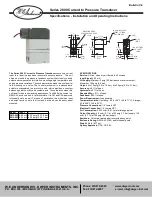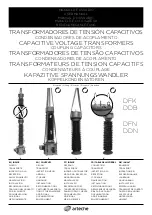
Page 3 of 4
GT_8-IOM Rev. 0 7/19
Printed in USA
THIS INFORMATION IS SUBJECT TO THE CONTROLS OF THE EXPORT ADMINISTRATION REGULATIONS (EAR). THIS INFORMATION SHALL NOT BE PROVIDED TO
NON-US PERSONS OR TRANSFERRED BY ANY MEANS TO ANY LOCATION OUTSIDE THE UNITED STATES CONTRARY TO THE REQUIREMENTS OF THE EAR.
PRINCIPLE OF OPERATION
An increase in coil signal current drives the coil downward, out
of the magnet assembly, pushing the balance beam toward the
pilot nozzle. This action reduces the flow through the pilot
nozzle, increasing the backpressure.
For low volume models (GT18, GT38, or GT58), this is the
controlled output pressure.
For relay equipped models (GT28, GT48 or GT68), this
pressure above the diaphragm assembly drives the diaphragm
assembly downward, opening the relay nozzle and increasing
the output pressure. The output pressure will continue to
increase until it is equal to the pilot nozzle backpressure on top
of the diaphragm, and the forces are balanced.
A decrease in the input signal allows the coil to move into the
magnet assembly, which moves the beam away from the pilot
nozzle. This allows the flow through the nozzle to increase,
which reduces the pressure above the diaphragm assembly.
Since the output pressure is greater than the pilot nozzle
pressure, the diaphragm will move upward, allowing the relay
valve to close and the exhaust flow path to open. Air will flow
from the output side of the transducer and flow through the
relief port in the diaphragm assembly, venting to atmosphere
through exhaust holes in the diaphragm spacer. This relieving
/ exhausting action reduces the output pressure of the
transducer until equilibrium is established.
Figure 2 – Partial sectional view of transducer






















